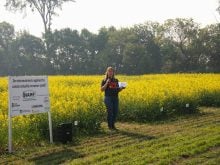One hundred years ago, a new building went up near the banks of the Red River on the University of Manitoba’s Winnipeg grounds.
The reddish brick building, built between September 1925 and March 1926, was to be a new point of the spear against cereal rust and crop disease. It was dubbed the Dominion Rust Research Laboratory and became a new hub for federal agriculture research in the province.
The result was decades of crop disease work and variety development that have helped shape Prairie crops as farmers know them today, attendees heard at an event in Brandon last month.
Read Also

Organic farmers urged to make better use of trade deals
Organic growers should be singing CUSMA’s praises, according to the Canadian Chamber of Commerce.
The Ahead by a Century event, hosted by the Manitoba Crop Alliance at the city’s Agriculture Canada research centre, marked 100 years of disease management and crop breeding in the province.
“Being a producer for 40 years of my life, I truly value the importance of continuing research and innovation,” said Manitoba agriculture minister Ron Kostyshyn at the event.
“Without our research that has been done (for) over 100 years, I think we’d honestly have to say that we would be in some challenging times.”
As time passed, the work done at the Winnipeg facility began to trickle out to new homes in the federal agriculture department’s network, according to communications staff at Agriculture Canada.
Breeding programs started to move to the federal research station in Brandon (established in 1886), first with barley, followed by wheat and oats.
By 2014, the Dominion Rust Research Laboratory (now called the Cereal Research Centre), closed its doors. The work was adopted by research stations in Brandon, Morden and other Winnipeg sites, the federal agriculture department said.
The wheat that Canadian farmers plant every year, for example, would be a lot different without Manitoba’s breeding program and the framework of variety development that the department pursues across the Prairies, attendees were told.
Varieties developed by Agriculture Canada account for 80 per cent of Canada’s wheat acreage, contribute $18 billion annually to the national economy and support an average of 248,000 full-time equivalent jobs across the country, said Agriculture Canada director general Felicitas Katepa-Mupondwa.

AAC Brandon alone, for example — developed in Swift Current, Sask., despite the Manitoba-sounding moniker — has consistently maintained a spot as one of the most popular wheat varieties on the Prairies since being released in the 2010s. It has been marketed based on its high yield, strong disease resistance and excellent milling and baking quality, and has impressed enough that farmers keep coming back year after year.
According to Manitoba Agricultural Services Corp. data, farmers reported seeding AAC Brandon on 28.9 per cent of Manitoba insured wheat acres this year — the most of any variety. Of the top five wheat varieties on MASC’s list this year, four came with the prefix “AAC.”
“This year marks 100 years of wheat research excellence, a century of innovation, collaboration and resilience,” Katepa-Mupondwa said.
She added that, on its own, “the Manitoba wheat breeding program has registered over 55 varieties, many of which are now staples in Canadian fields today.”
The research program operates through partnerships between Agriculture Canada, provincial governments and producer organizations such as the Manitoba Crop Alliance, the Canadian Wheat Research Coalition, Saskatchewan Wheat, Alberta Grains and the Western Grains Research Foundation.
One of the biggest challenges producers face today is disease, which can devastate crops, hurt farm income and threaten food security. That’s why disease research is so integral, Kostyshyn said.
“Research on disease resistance in cereals … has a huge impact on cereal production in Canada and around the world,” he said.
The Brandon Research and Development Centre continues to co-lead national wheat breeding research, working collaboratively with other federal stations across the country, as well as the University of Manitoba, University of Saskatchewan and University of Alberta. The program develops germplasm specifically adapted to eastern and northern Prairie growing conditions.
Looking ahead, Katepa-Mupondwa believes the future of research, and therefore agriculture, holds much promise.
“As someone who has dedicated much of my life to agricultural science, I am convinced that the next century will indeed be even more innovative, inclusive and impactful,” she said.
















